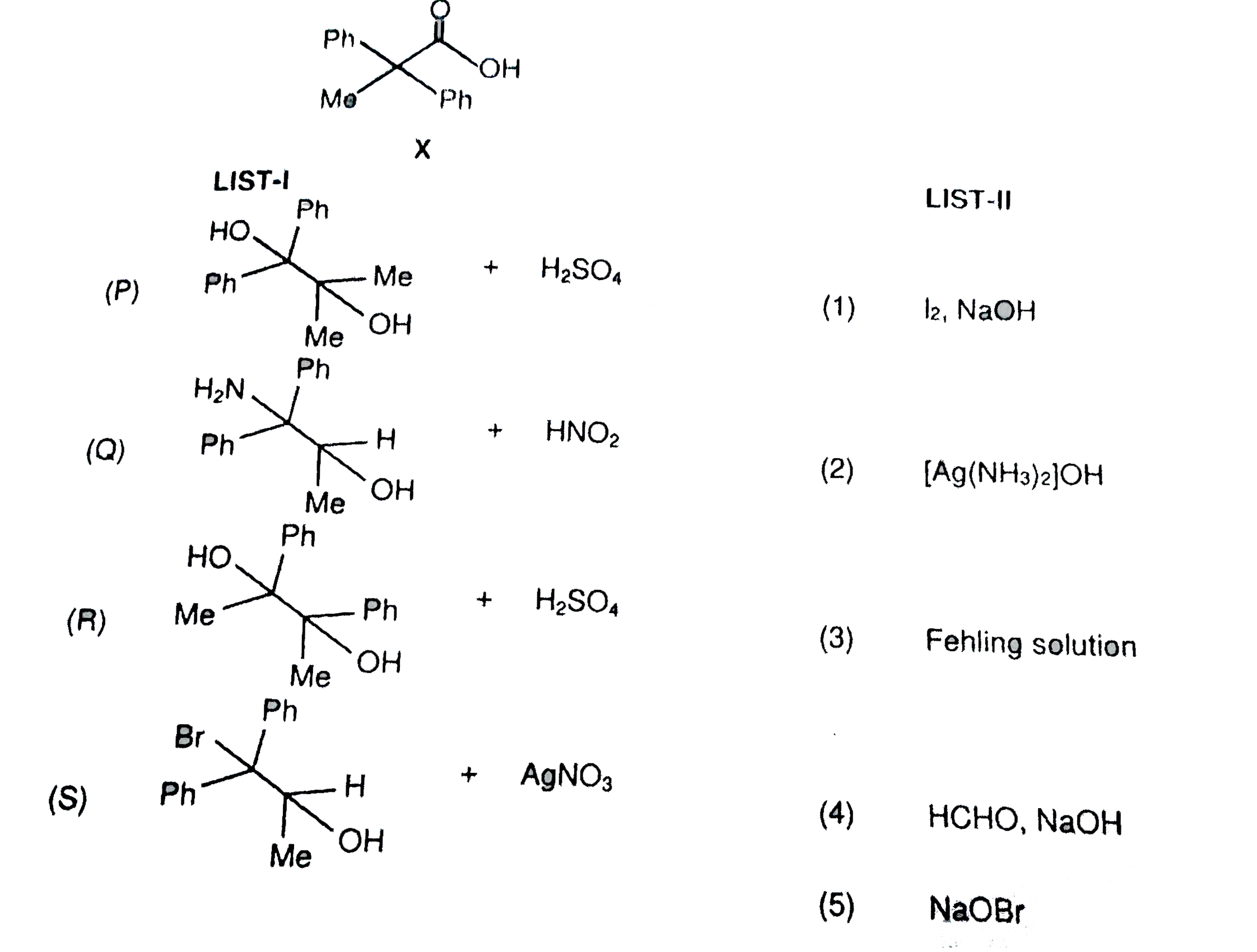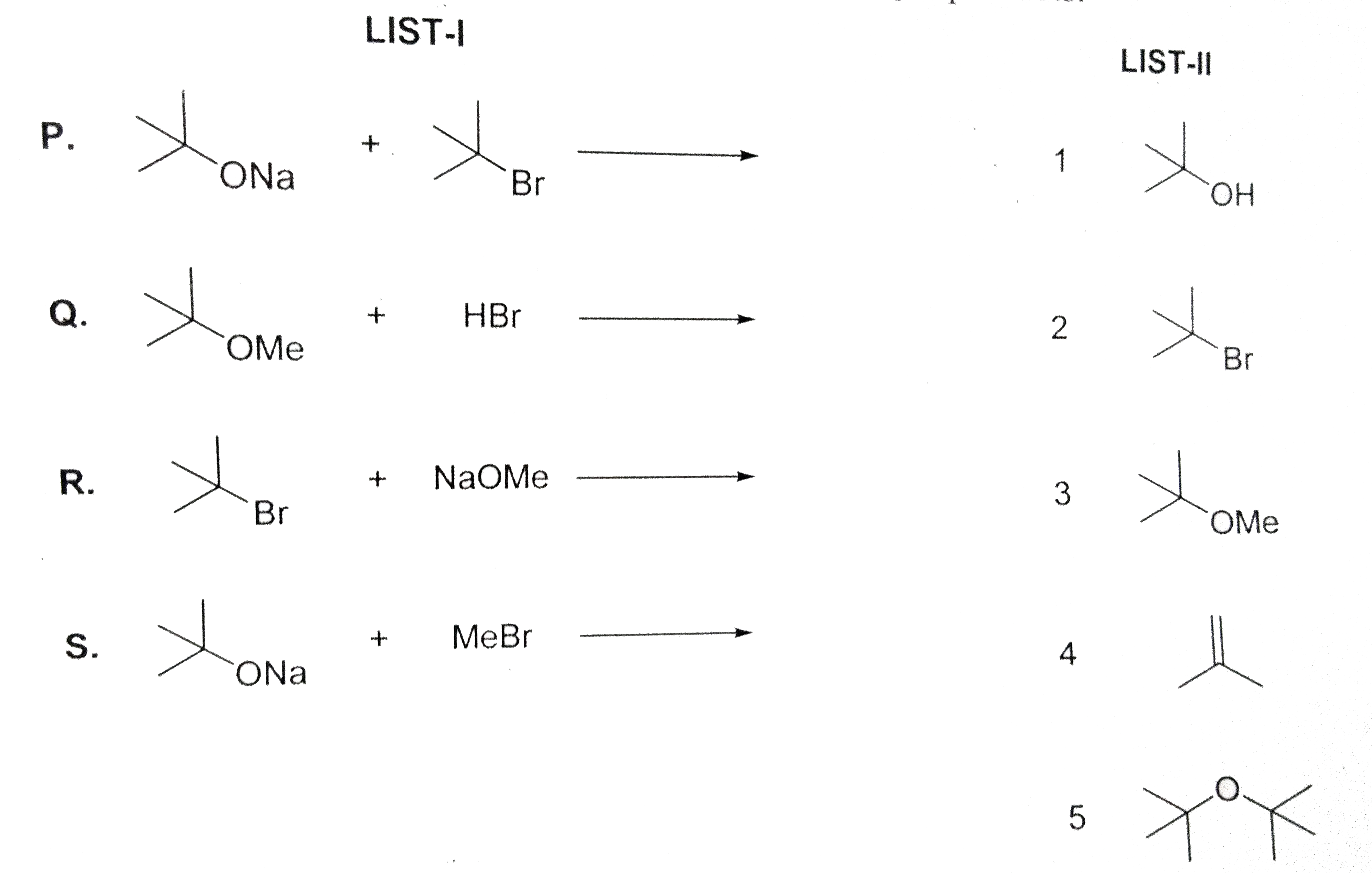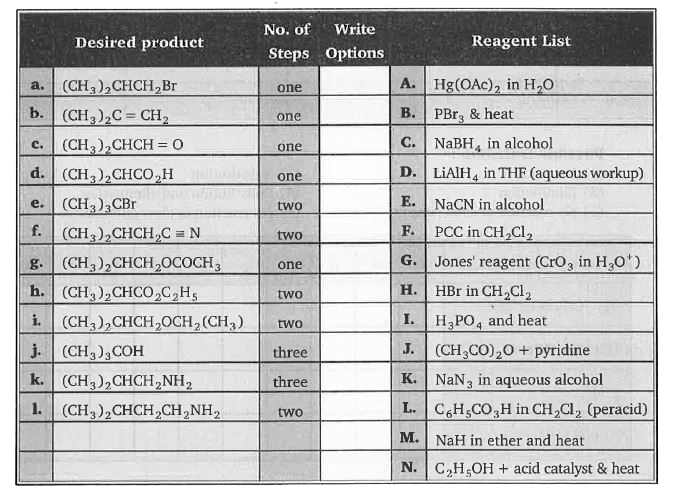The desired product X can be prepared by reacting the major product of the reaction in LIST-1 with one or more appropriate reagents in LIST-II (Given . Order of migratory aptitude : aryl gt alkyl gt hydrogen )

P→1 , Q→2,3 , R→1,4 , S→2,4
P→1,5 , Q→3,4 , R→4,5 , S→3
P→1,5 , Q→3,4 , R→5 , S→2,4
P→1,5 , Q→2,3 , R→1,5 , S→2,3
The correct Answer is:D
Step by step video & image solution for The desired product X can be prepared by reacting the major product of the reaction in LIST-1 with one or more appropriate reagents in LIST-II (Given . Order of migratory aptitude : aryl gt alkyl gt hydrogen ) by Chemistry experts to help you in doubts & scoring excellent marks in Class 11 exams.
Updated on:21/07/2023Topper's Solved these Questions
- ORGANIC REACTION MECHANISMS-IVBOOK - RESONANCE ENGLISHCHAPTER - ORGANIC REACTION MECHANISMS-IVEXERCISE - Exercise-3 Part-2 JEE (MAIN ) OFFLINE PROBLEMS
10 Videos
- ORGANIC REACTION MECHANISMS-IVBOOK - RESONANCE ENGLISHCHAPTER - ORGANIC REACTION MECHANISMS-IVEXERCISE - Exercise-3 Part-2 JEE (MAIN ) ONLINE PROBLEMS
10 Videos
- ORGANIC REACTION MECHANISMS-IVBOOK - RESONANCE ENGLISHCHAPTER - ORGANIC REACTION MECHANISMS-IVEXERCISE - Exercise-2 Part-4
8 Videos
- ORGANIC REACTION MECHANISMS - IIBOOK - RESONANCE ENGLISHCHAPTER - ORGANIC REACTION MECHANISMS - IIEXERCISE - APSP Part - 3
22 Videos
- PERIODIC TABLE & PERIODICITYBOOK - RESONANCE ENGLISHCHAPTER - PERIODIC TABLE & PERIODICITYEXERCISE - ORGANIC CHEMISTRY(BASIC CONCEPTS)
27 Videos
Similar Questions
An alkyl isocyanide can be prepared as a major product by which of the following reaction?
View SolutionLIST-I contains reactions and LIST-II contains major products.

View SolutionRead the following paragraph and answer the questions given below ,
Stable equilibrium is of various types . Mechanical equilibrium is achieved when all particles are at rest and total potential energy of the system is minimum . At any stage where particles are at rest but the system is not at stable equilibrium as it can reduce its potential energy by reverting to another position, is called metastable equilibrium . Thermal equilibrium is result from the absence of temperature gradients in the system. Chemical equilibrium is obtained when no further reaction occurs between reacting substances, i.e forward and reverse rates of reaction are equal. when steam with solid iron at high temperature Fe3O4(s) and hydrogen gas are produced . But the reaction never goes to completion. this is because as the products are formed the reaction proceeds in reverse direction and when rate of reverse reaction is equal to rate of forward reaction , the concentration of reactants and products become constant and equilibrium is reached.
When a matchbox is balanced on its edge, it is unstable and will tumble to a more stable position resting on its face so as to acquire minimum potential energy. This is an example of
View SolutionRead the following paragraph and answer the questions given below ,
Stable equilibrium is of various type . Mechanical equilibrium is achieved when all particles are at rest and total potential energy of the system is minimum . At any stage where particles are at rest but the system is not at stabel equilibrium as it can reduce its potential energy by reverting to another position, is called metastable equilibrium . Thermal equilibrium is result from the absence of temperature gradients in the system. chemical equilibrium is obtained when no further reaction occurs between reacting substances, i.e forward and reverse rates of reaction are equal. when steam with solid iron at high temperature Fe3O4(s) and hydrogen gas are produced . But the reaction never goes to completion. this is because as the products are formed the reaction proceeds in reverse direction and when rate of reverse reaction is equal to rate of forward reaction , the concentration of reactants and products become constant and equilibrium is reached.
The correct expression for equilibrium constant of the reaction, taken as an example of chemical equilibrium in the above passage is
View SolutionIsobutyl alcohol (2-methyl-1-propanol) (CH3)2CHCH2OH, can be transformed to each of the compounds (a through 1) listed in the left-hand column. In each case the number of steps needed to accomplish the change is noted, and an answer box is provided for your reagent Write letters designating the reagent or reagents you believe will achieve the desired transformation in the box to the right of the product formula. In the case of a multi-step sequence write the reagents in the order they are to be used. In some cases you maywish to use a previously prepared compound as a reactant. If so, write the number (a to 1) corresponding to the desired compound.

View SolutionIt we see the reaction of methane with halogen, the rate determining step for chlorination is, endothermic reaction of the chlorine atom with methane to form methyl radical and a molecule of HCl. So free radical is the intermediate of the reaction. Formation of free radical depends upon the energy required to break a bond between a hydrogen atom and a carbon atom. Chlorination of propane and Bromination of propane. when compared it is found that bromination is more selective than chlorination. The probability factor for 3∘,2∘,1∘H atom is 5.0:3.8:1.0 at 25∘C for chlorination.
Isobutane when reacts with chlorine in presence of ultra violet radiations yield 2 products primary hydrogen substituted and 3∘ hydrogen substituted Find their % in product mixture
View SolutionStabilities of alkanes can be compared by converting these compounds to a common product and comparing the amount of the heat given off. One possiblitiy would be to measure the heat of combustion from converting alkenes to xo2 and H2O . The heats of combustion are of large values and measuring small difference in these large numbers is difficult. Alkene of the lowest heat of combustion among isomeric alkenes is of the lowest energy and is most stable.
Th stability of alkenes is often compared by meansuring the ehat of hydrogenation 9 heat given off, ΔH∘h during catalytic hydrogenation. The heat of hydrogenation is in smal number, which provides more accurate energy difference.
For a compound containing more than one double bond, Δ∘h is the sum of heat of hydrogenation of individual double bonds. For non − conjugated diens, this additive relatioship is found to hold. For conjugated dienes, however, the measured value is slightly lower than expected. Cumulated dienes, which are even less stable than non − conjugated dienes.
The more stable is the alkene, lower is the heat of combustion and heat of hydrogenation. More highly substituted double bonds are usually more stable. In case of cyclokanes, compounds having higher angle strin are less stable.
If the heat of hydrogenation of cyclooctene is about 23kcalmo−1, what would be the probable ΔHb or 1,3,5,7−cyclooctatetraene ?
View SolutionRead the following paragraph and answer the questions given below ,
Stable equilibrium is of various types . Mechanical equilibrium is achieved when all particles are at rest and total potential energy of the system is minimum . At any stage where particles are at rest but the system is not at stable equilibrium as it can reduce its potential energy by reverting to another position, is called metastable equilibrium . Thermal equilibrium is result from the absence of temperature gradients in the system. Chemical equilibrium is obtained when no further reaction occurs between reacting substances, i.e forward and reverse rates of reaction are equal.
When steam with solid iron at high temperature Fe3O4(s) and hydrogen gas are produced . But the reaction never goes to completion. This is because as the products are formed the reaction proceeds in reverse direction and when rate of reverse reaction is equal to rate of forward reaction , the concentration of reactants and products become constant and equilibrium is reached.
The primary objective of the passage is
View SolutionStabilities of alkanes can be compared by converting these compounds to a common product and comparing the amount of the heat given off. One possibility would be to measure the heat of combustion from converting alkenes to CO2 and H2O . The heats of combustion are of large values and measuring small difference in these large numbers is difficult. Alkene of the lowest heat of combustion among isomeric alkenes is of the lowest energy and is most stable.
Th stability of alkenes is often compared by meansuring the ehat of hydrogenation 9 heat given off, ΔH∘h during catalytic hydrogenation. The heat of hydrogenation is in smal number, which provides more accurate energy difference.
For a compound containing more than one double bond, Δ∘h is the sum of heat of hydrogenation of individual double bonds. For non − conjugated diens, this additive relatioship is found to hold. For conjugated dienes, however, the measured value is slightly lower than expected. Cumulated dienes, which are even less stable than non − conjugated dienes.
The more stable is the alkene, lower is the heat of combustion and heat of hydrogenation. More highly substituted double bonds are usually more stable. In case of cyclokanes, compounds having higher angle strin are less stable.
Which statement is false ?
View SolutionStabilities of alkanes can be compared by converting these compounds to a common product and comparing the amount of the heat given off. One possibility would be to measure the heat of combustion from converting alkenes to CO2 and H2O . The heats of combustion are of large values and measuring small difference in these large numbers is difficult. Alkene of the lowest heat of combustion among isomeric alkenes is of the lowest energy and is most stable.
Th stability of alkenes is often compared by meansuring the ehat of hydrogenation 9 heat given off, ΔH∘h during catalytic hydrogenation. The heat of hydrogenation is in smal number, which provides more accurate energy difference.
For a compound containing more than one double bond, Δ∘h is the sum of heat of hydrogenation of individual double bonds. For non − conjugated diens, this additive relatioship is found to hold. For conjugated dienes, however, the measured value is slightly lower than expected. Cumulated dienes, which are even less stable than non − conjugated dienes.
The more stable is the alkene, lower is the heat of combustion and heat of hydrogenation. More highly substituted double bonds are usually more stable. In case of cyclokanes, compounds having higher angle strin are less stable.
In which of the following is ΔH_(h)∘ the maximum ?
View Solution
